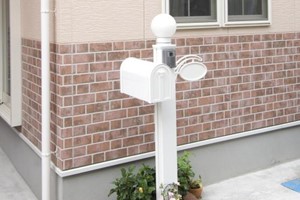Masonry veneer is a construction material used on the exterior walls of homes and commercial buildings. It is comprised of thin pieces of brick or stone, and gives the appearance of solid masonry without the associated weight and cost. The masonry veneer is attached to the building's structure, but is self-supporting, and places no additional loads on the building's structural components. Because it is primarily used for its appearance, and is non-load bearing, masonry veneer walls are often referred to as “curtain walls.
There are two basic methods of constructing walls using masonry veneer. The first is known as an anchored system, and relies on brick ties and angle brackets to anchor the veneer wall to the building's structural framing. The second type of masonry wall construction is an adhered system. Using this technique, the veneer is attached to the structure using a thin layer of mortar, without the need for brick ties. Many local building codes specify when each of these systems may be used, based on the building design and the risk of high winds or other weather-related factors.
The outermost layer of these walls is made from the masonry veneer and mortar. Depending on the type of veneer being used, the stone may be installed against a backer board made from dense foam or plywood. In the case of brick veneer, the masonry exterior may simply be self-supporting, with no backer board required. An air cavity is typically maintained behind the veneer, and is used for drainage. At the innermost layer of the wall is the building's structural system, which may consist of masonry blocks or traditional steel or wood framing.
Masonry veneer offers a number of advantages over other types of construction. The air cavity in these walls allows for effective drainage, which keeps water or moisture from damaging the home. The water is able to travel freely to the base of the air cavity, where it is drained to the exterior through tiny holes in the veneer called “weep holes.” The air cavity also provides room for insulation, which can help improve the thermal resistance of the walls.
Walls built using veneer can be built more quickly and affordably than traditional masonry walls. Veneer costs are typically lower than that of brick or stone, and the light weight of the veneer allows for more efficient installation, which can lower labor costs. The comparatively low weight of veneer also means that the building's foundation system can be smaller and less complex. Finally, because the veneer walls are non-structural, they can be installed after the building's walls and roof, providing a great deal of flexibility for builders.
More Durability, Less Maintenance
Brick veneer also requires less maintenance than regular wood or vinyl siding. You don't have to repaint it, and its fade-resistant qualities keep your home looking beautiful for years to come. Since it has no wood content, it's not vulnerable to damage from termites, carpenter ants or other wood-loving pests. Moreover, it doesn't have the same risks of rotting, mildewing and warping.
Aesthetics and reduced maintenance cost aside, masonry veneer has other benefits. It's made from stone materials like clay and shale, which come from our earth's crust. When it's broken down and crumbled, the resulting substrate can be used in new building materials. Brick veneer also has a slightly higher R-value than vinyl, fiber cement or wood siding. Why does that matter? Well, the R-value signifies a material's ability to slow down heat transfer. Brick veneer averages at 0.80 R-value, higher than the 0.61 average for vinyl siding, 0.50 for fiber cement and 0.70 for wood siding.
How To Drill Through Masonry Veneer Without Cracking
Drilling through masonry veneer isn't as precarious as it sounds. However, you do need to observe proper techniques to get the best results. Generally speaking, it's less risky to drill smaller holes than larger ones. It also depends on the reason you want to drill into the veneer, plus whether it's installed inside your home or on the exterior walls.
Before you start drilling into the veneer, you must find out some important information: the thickness of the veneer, what lies behind it and the locations of any wall studs. If the veneer is rather thin, you may want to consider other options. If drilling into the veneer is a go, you must have essential supplies on hand:
- Safety goggles
- Drill and masonry drill bits
- Pencil or permanent marker
- Masonry brush
Before your begin drilling, mark the exact spot with your pencil or marker. You'll get your best results using a variable speed drill and pressing firmly into the veneer as you go. Besides masonry drill bits, you may get good results from using a diamond-tipped hole saw. It's originally designed to drill through glass, porcelain and ceramic, but its brazed tip and accuracy create clean, precise holes. You'll also use less pressure on your drill when it's equipped with a diamond-tipped hole saw. Once you're done drilling, remove any excess dust with your masonry brush.











